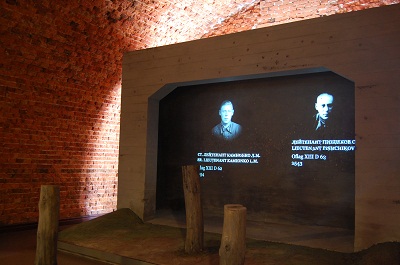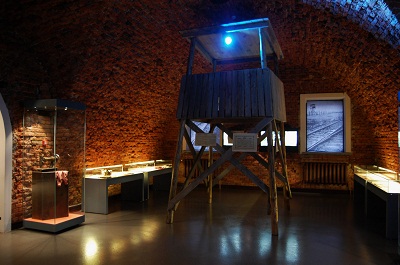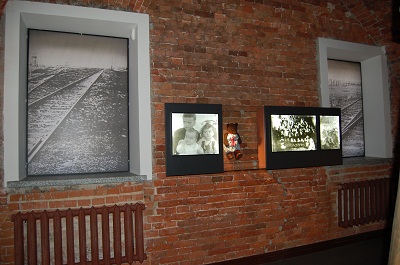Hall 4. «Challenge»
Dahau was one of the first concentration camps on the Germany territory. It was built in March 1933 and became the first “testing ground” for the prisoners’ punishment system. Mass people shootings have been carried out on the territory of the former Dahau-Heberthausen ground. Around 250000 people from 24 different countries went through this camp during the whole time of its existence. 70000 of them died, where 12000 were the soviet prisoners of war. The place of soviet prisoners’ of war death was the Heberthausen ground, located within 1,5 km from Dahau. Mass people shootings have been carried out there. People were delivered to the railway station and then sent to the Heberthausen ground, where SS troops practiced shooting at live targets on them. Prisoners were enchained with handcuffs to the stakes before the walls, so they could not escape. The shot ones were taken to the crematorium of the concentration camp and burned. During 1941 – 1942 around 4000 political workers, communists, frontier guards, Jews and other soviet prisoner of war were slaughtered there. Today only 900 names of those people are known.

The model of Heberthausen ground firing wall standing in the right part of the hall is used as a projection screen, where the picture from Brest Fortress defenders who died in captivity appear time after time. The picture of gunpowder cellar at the Terespol fortification appears among them. This place served as a firing wall for the first days of the war, where fascists shot first captives from the fortress defense. “The directive on the political commissars’ treatment” from the 6th of June 1941 is the evidence of the goals and methods of the war, which was waged by Nazi-Germany against USSR. The watchtower model standing in the left part of the hall is a symbol of fascist occupation, oppression and annihilation of Brest civilians. The tower is pasted with different adverts on Russian, German, Polish and Ukrainian languages. The first adverts have been printed on the back side of the soviet newspaper “Zarya”, which did not make it from the Brest printing shop on the 22nd of June 1941. This was the way of the new power to secure their orders. Starting from the first days of war, the city of Brest and its region have been occupied by fascist troops. The occupation of the city lasted 1132 days. During this period from 70000 almost 15000 civilians of the prewar city stayed alive. The rest of them died in prisons or ghetto, have been shot or taken to Germany for labor.

The materials in the showcase on the left side of the hall tell the stories about the period of the occupation: sewing machine from the fortress defender’s I. Nozdrin family; the shirt that belonged to Larysa Kuznetsova, the daughter of the commander of the 17th Red Army frontier-line squad L. Kuznetsov; the books from the Brest Fortress military units’ libraries that have been found between 1941 and 1942 by one of the local residents Y. Stolyarchuk; the mug from the Brest prison that belonged to P. Bondar; the “OST” sign from N. Ilyina; the materials about the involvement of commanding crew family members in partisan movement. The documents and pictures talk about crimes committed by the invaders on the Brest land: children of the Brest garrison commanding crew that have been shot during the years of occupation (the pupils’ list from the 7th grade, middle school #15 of Brest between 1940 and 1941 academic years, compiled by V. Zenkina – Sachkovskaya); the other pictures show the children of captain V. Rozhnyatovsky and the foster-children from Domachevo orphanage that have been shot in 1942.

The prewar soft toy, a plush bear, serves as a symbol of lost childhood. The liberation came during the summer of 1944 with the advent of Red Army units that freed the city of Brest. Camp prisoners returned to their Homeland after months or even years. The showcases on the right present the documents of the former prisoners of war: R. Semenyuk, A. Makhnach, T. Ulanov, B. Naumets, I. Dolotov. The letter from A. Makhnach sent to his Homeland in April of 1945 are full of joy from liberation: “Hello dear Homeland!!! Hello dear parents: father, mother, brothers Nikolaj and Viktor and sister Lidia. I send you my best regards and kisses. Now I am free. On April 9th 1945 I was born again. On this day our ally Canadian troop freed the concentration camp on the border with Holland amidst the deserted swamps. That is where we were delivered on the 1st of December 1944, together with 500 commanding officers. In this place around 18-20 people were dying from hunger every day. Whoever was taken there never came back… Only because of Canadian troops me, my comrades and the other survivors were released…”. However, after coming back to the Homeland and going through the initial check, former prisoners of war were about to go through new challenges.
